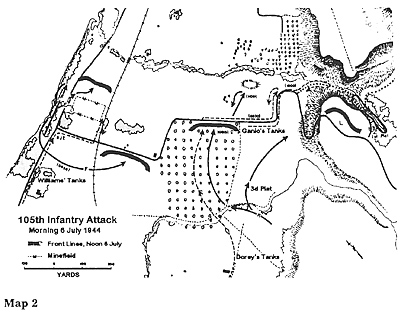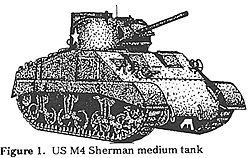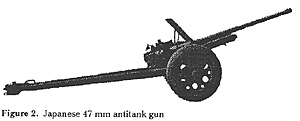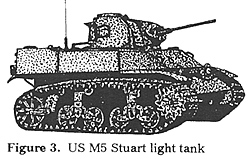
Under pressure from Division to move promptly and reach their objectives, both battalions of the 105th were ready to attack at 0700 on 6 July (Map 2).
Maj. Edward A. McCarthy, commanding the 2d Battalion of the 105th, planned his attack with an eye to avoiding the sector where he had met trouble on the previous afternoon. Ahead of his night position, beyond the first stretch of the cross-island road, was the extensive minefield which had stopped his tanks the day before and which was in an area effectively interdicted by intense enemy fire. The mines occupied virtually the whole space between highway and railroad tracks, to an estimated depth of 100 yards.
A little beyond this minefield a deep ditch ran from the base of the cliffs to the sea, providing perfect cover for enemy movement and also constituting a possible tank trap. South of the minefield, toward the coconut grove, the ground was open and could be easily covered by fire from any Japanese positions along the cliffs. McCarthy decided to bypass this whole zone by slipping his battalion to the left, along the narrow strip of beach between the water and the coastal highway. That route would bring the 2d Battalion into a zone of prepared beach defenses, made up mainly of pillboxes emplaced for defense against landings from the sea. In order to eliminate them, McCarthy decided on an old-fashioned rolling barrage which would force the Japanese to hole up in their shelters. The infantry, following close behind this fire, would catch the enemy in their holes before they could emerge to man the firing positions.
The assault would be made in column of companies, with F leading. Company E was to follow and fan out to the right of the beach as soon as the minefield was passed. Company G, in reserve, was ordered to move back over the ground covered on 5 July, mopping up enemy elements that might have infiltrated during the night. A patrol of E was sent to the right to locate Company K, which was thought to be pushing through the coconut grove, so that E after deploying beyond the minefield could tie in with K. The patrol, three men under Sgt. Carlos A. Harris, left promptly at 0700.
The battalion attack moved off on schedule, with the 249th Field Artillery Battalion putting heavy, concentrated fire on the whole area beyond the minefield. In Company F, lst Lt. John E. Titterington had placed his left platoon (3d) between the road and the water's edge, while the 2d Platoon moved just right of the highway, skirting the edge of the minefield.
The advance of F Company was well coordinated and rapid, the men moving out all along the line in a series of rushes. Within a few minutes of the jump-off, both assault platoons had almost passed beyond the northern limits of the minefield, a gain of approximately 100 yards. This brought them to a point about 150 yards short of the ditch that crossed the coastal plain at right angles to the axis of advance. Company E, following close behind, was almost in position to fan out to the right.
At this point the artillery fire shifted on up the road to the east and left the ditch area. Almost at once there was a heavy burst of enemy machine gun fire, followed by a fusillade of small arms. All of the men were forced to go to earth, but they were in an extremely exposed position and began to suffer casualties. The plain was covered with foot- high grass that offered little concealment. Major McCarthy, who was with Company E, tried to get the men to start forward, moving up and down the line yelling "Up and at 'em," but the first two men in Company E who tried to get up and move were hit and killed immediately.
The fire had now become intense and the whole area was alive with bullets. The supporting artillery fire was falling some distance away and had no effect on the immediate situation. So well concealed were the Japanese that none of the men along the narrow battalion front could locate the enemy fire positions.
Major McCarthy now began to try to bring up tanks or SPM's to lay down some direct fire support along the front, but when he tried to get hold of his CP by radio there was no answer. His own radio was out, and so was Capt. Clinton F. Smith's. In this emergency he sent his runner back to order up the vehicles, a mission which turned out to be a particularly slow and tedious task. By this time anyone who lifted up his head would draw heavy and accurate fire on himself, so that the runner had to crawl slowly and carefully back a distance of 150 yards before he could move rapidly. When he did get to the battalion CP, the tanks were not there and he had to go along the road all the way to Regiment on the far side of Tanapag before he was able to get the tank platoon leader and bring him up. It was 1000 before the tanks came rumbling up the road to Road Junction 2.
The period between approximately 0730, when the attack had bogged down, and the arrival of the tanks, was not entirely lost. Major McCarthy spent the first part of that time in maneuvering his men to prevent any possibility of a successful Japanese counterattack. Company E, by crawling and wriggling ahead, managed to deploy itself on a three-platoon front between the road and a point about 75 yards to the south. From this ground, just east of the minefield, the men spent the rest of the morning trying to locate the source of the fire that was causing the delay. Slowly but surely the men inched forward, a little at a time. By noon they were only 100 yards short of the ditch. About 0900, Major McCarthy decided to withdraw Company F from their cramped area between the road and the beach. He had received word from Sergeant Harris' patrol regarding the movement of Company K and now, with Company E operating along the railroad track and the road, he resolved to use Company F between E and K.
He transmitted the orders to 1st Lieutenant Titterington, and Company F had moved back out of the beach corridor at about the time the tanks arrived at Road Junction 2. Within an hour F had marched some distance around the rear of the line and was moving into position in the gap between the 2d and 3d Battalions. Carried out with caution, the movement was accomplished without casualties.
The 2d Battalion commander had also given his attention to the minefield that was causing so much trouble. Shortly before 0900 he called up his battalion engineer officer, 1st Lt. Richard M. Hughes, and ordered him to make a reconnaissance of the mined area. Hughes had to crawl through the minefield on his stomach because of the intense fire, but before 1000 had reported back that the field was about 50 by 100 yards and was composed of upended aerial bombs, fused as mines. He volunteered to begin removal at once and brought up his platoon from Company A, 102d Engineer Combat Battalion, to begin the job. This platoon had to work while lying flat and under constant heavy fire, a situation which made their task extremely slow.
With the arrival of the tanks, Major McCarthy was faced with the problem of getting them into position to lay down covering and supporting fire. The road was a questionable route of approach because of the interdicting fire. Furthermore, the road crossed the ditch ahead over a narrow bridge, which was almost certain to be mined. The beach could be used only with difficulty, and houses, trees, and shrubbery along the north side of the road cut down the fields of fire considerably. But Lieutenant Hughes in his reconnaissance had crept out along the railroad track for some distance and had ascertained the fact that it was not mined, so Major McCarthy determined to send his tanks along the right of way.
 Figure 1. US M4 Sherman medium tank
Figure 1. US M4 Sherman medium tank
The tank force consisted of five mediums under the command of 1st Lt. Dudley A- Williams of the 762d Tank Battalion. The narrowness of the right of way made it necessary for these vehicles to proceed in single file along the roadbed. Williams sent them out about 20 yards apart. The lead tank crept along almost to the north edge of the minefield. There its tracks picked up one of the thin steel rails, and within a few seconds was unable to move in any direction. The tank was still far short of a point where it could do any good with its guns; tangled up as it was in the now twisted rails and ties of the cane railroad, it effectively blocked the path of the next tank behind it. Lieutenant Hughes was called over and was put to work with his men in an effort to clear a path through the minefield so that the second tank could be worked around the disabled one.
While this work was in progress, the enemy brought antitank guns to bear along the railroad track; on the first two shots, both tanks were hit, although neither was put out of action. The crews reported that they "could see daylight through their tanks." Lieutenant Williams immediately asked for permission to get the vehicles out of the danger area until a route of approach could be laid out which would enable his tanks to keep moving. Major McCarthy agreeing, a cable was hooked onto the lead tank and both vehicles were hauled loose and clear of the area.
It was now after 1100, and the attack of the 2d Battalion had shown little or no progress. Company E was effectively pinned down between the minefield and the ditch across the front, about 150 yards north of Road Junction 2 where they had started. Company F had taken up a line behind the road that ran from Road Junction 2 to the coconut grove, holding there until the situation cleared up to the front. As yet no one had been able to locate accurately the source of the Japanese fire. Intelligence on this problem was achieved quite by accident, shortly after the tanks were pulled back out of danger.
While the two tanks were trying to move along the railroad track, the left platoon (lst) of Company E had been drawn up between the road and the beach. Extending from the road to the nailroad track was the 3d Platoon. Both of these units were laying down a covering fire to the front, when one of the men, Pfc. Edwin J. Kula, happened to notice movement in the ditch close ahead. He called the attention of S/Sgt. Angelo D. Nicolette, his platoon sergeant, to the possibility that one of the enemy machine guns was located in the gully, and Nicolette immediately called for 60 mm mortar fire to be directed into the ditch.
He was notified, in return, that the mortar section was out of ammunition and did not expect a resupply for some time. He crawled back, then, to Road Junction 2 and talked with the driver of an SPM of the 105th Cannon Company, which had just come up the road. The driver agreed to work up the coastal road as far as he could in an effort to put fire into the spot which Private Kula had suspected. Nicolette climbed aboard and the vehicle started out, but before it had gone ten yards the same antitank fire which damaged Lieutenant Williams' two tanks began landing in the area. In view of this fire, the SPM commander decided to pull back out of the exposed area. The project was abandoned for the time being.
 Figure 2. Japanese 47 mm antitank gun
Figure 2. Japanese 47 mm antitank gun
Sergeant Nicolette was still convinced that he could get rid of this one position at least. After some discussion with Captain Smith, he got permission to withdraw his platoon from the area along the beach and, moving around and up the railroad track, to see if he could bring fire on the ditch from there. The men had to move the whole distance by crawling, so that it was past noon before they reached a place from which they could bring weapons to bear. It cost Company E one more man wounded, and after the platoon had reached its new position it found itself still unable to do anything about the enemy gun in the ditch.
S/Sgt. William H. Allen, one of the sq#ad leaders, now asked permission to take his squad, rush the ditd h, and try to knock out the position in that manner. After carefully organizing his men, Sergeant Allen started out in a swift dash'toward the trench. Almost immediately the enemy fire resumed in full strength, and most of Allen's men had to duck for cover. The sergeant, who was first up and running, made a jump for the ditch and landed there, only to find himself sprawling in the midst of about eight enemy soldiers. Allen reacted automatically, shooting two of the Japanese and bayoneting a third.
In the melee that followed he was shot in the leg by a bullet that wounded him in four different places. Up to that moment, the squad leader had not realized he was without support, but now he looked around and decided that he was outnumbered. In one dive he was out of the ditch and crawling back toward his company. Although wounded painfully, Allen insisted that he be allowed to take his squad back to clean out the remaining enemy soldiers. He thought there were only five left. However, the volume of fire that was directed at him after he came back out of the gully had, for the first time, given Major McCarthy and his company commanders some idea as to where the main enemy strength lay. Clearly the Japanese held the ditch in large numbers, and most of the terrible and intense fire that was keeping the men down was coming from this source, not more than 100 yards away. Allen was not permitted to return to the ditch to "clean it out." It was now approximately 1300 and the 2d Battalion still had not been able to get going.
 Figure 3. US M5 Stuart light tank
Figure 3. US M5 Stuart light tank
The battle on the Tanapag Plain had been just as bitter in front of Company K, which started the day facing the coconut grove. This company, like the 2d Battalion, was ready to move off in the attack at 0700, accompanied by a platoon of light tanks under 1st Lt. Willis K. Dorey.
1st Lt. Roger P. Peyre, profiting by the experience of his company on the previous afternoon, ordered K's men to move up along a deep gully that circled along the southwest edge of the grove, making use of the cover and concealment that it offered. Stealing along this trench, the men were able to get almost into the grove itself before they were detected, but as they emerged from defilade they were taken under fire by at least two machine guns firing from deep within the grove. For a short time the whole company was pinned down, unable to locate the source of fire.
It was at this point that Sergeant Harris and his patrol from Company E blundered into the coconut grove from the west. Sergeant Harris had been told that he would probably find Lieutenant Peyre in the grove, and had worked his way directly there without realizing that it was still in the hands of the enemy. He and his two men, Pfc. John Lopez and Pvt. Keith M. Jarrell, had no sooner entered the trees than a machine gun opened up from 25 yards' distance, wounding Harris seriously in the back. Private Lopez spotted the gun at once in a small, criblike building.
He told Private Jarrell to crawl back out of the grove and get back to Captain Smith with the information that Harris had been wounded. He himself would stay with the wounded sergeant to guard him until Jarrell could get back with help. For several minutes Lopez lay on the ground with his charge, and in that period was able to spot and accurately mark the Japanese machine gun positions in the grove. While thus engaged he noticed Company K trying to work forward against this fire and without hesitation got to his knees, endeavoring to attract attention to himself and to point out the gun positions. When this failed, Lopez made his way by short rushes to a point at the rear of the grove where he could see Dorey's tanks. It took him only a few moments to orient the tank commander on the Japanese positions, and Dorey immediately waded into the grove with his guns blazing.
Ten minutes later two machine gun positions had been completely destroyed and Peyre's men were moving up into the grove. For over an hour Company K worked their way among tremendous stockpiles of supplies, mostly foodstuffs, poking around in these piles in search of str-ay enemy soldiers. By 0815 they were through to the north edge of the trees, facing the open ground beyond the cross-island road.
Not all of Company K had taken part in the advance through the grove. Lieutenant Peyre had placed his 3d Platoon on the right of his line with instructions to keep in sight of Company L on the hills south of Harakiri Gulch. Shortly after the rest of the company began to pull through the grove, this platoon was forced to draw to the right to maintain their contact with Company L; as a result they soon became completely separated from the remainder of their own unit. Their move brought the platoon out into the open ground just south of the grove and almost directly beneath the hills.
From the very first they began drawing heavy fire from the cliffs to their right front, particularly from the north nose of the entrance to Harakiri Gulch. Using cover as much as possible the platoon managed to reach the turn in the road where it began its ascent of the hills. There fire became so intense that further movement was impossible. Lieutenant Peyre immediately ordered Dorey to take his tanks and move along the cross-island road until he reached a position from which he could put effective fire on the cliff positions to the right front. This was at 0830.
Dorey's fire worked particularly well against the enemy positions along the cliffs. It was only a matter of a few minutes before the Japanese had been driven off their guns all along the line and the fire died down. As long as Dorey fired, the men of Company K were able to move about at will, but the moment there was any lull the soldiers could see the enemy coming back toward their guns. As a result, Dorey had to keep up a constant fire. Lieutenant Peyre was trying to coordinate this fire so that his infantrymen could advance under its support, but tank-infantry communications failed at this critical point. Peyre could neither reach Dorey on the radio nor make any impression on him with hand and arm signals.
As a result Dorey simply kept patrolling up and down the road, laying down a blanket of fire on the cliffs which kept the enemy from firing, but which also kept Company K from advancing through his line of fire. Suddenly, at about 1000, Dorey pulled his tanks over to where Lieutenant Peyre had established his CP, just inside the cover of the grove, and informed him that he was almost out of ammunition and would have to return to the dumps for a resupply. He would be gone for approximately half an hour. Peyre could do nothing but let the tankers go.
His situation was not too critical. On this section of the front, in contrast to what McCarthy was facing, the Japanese positions had been accurately located. A hundred yards ahead of Company K, in the open terrain north of the grove, a small rise in the ground forming a knoll extended part way across Peyre's zone of action. Company K had now definitely located three enemy machine gun positions behind this rise, near the same ditch that extended in front of the 2d Battalion, and all morning Dorey's tanks had put enough fire into the area to keep the Japanese from manning the guns. In addition, most of the cave positions in the side of the cliff above the ditch had been spotted and interdicted. As long as the enemy could be kept from using these weapons, Peyre's position was quite secure and tenable. Advance was another question; any forward move would carry Company K opposite the mouth of Harakiri Gulch, and, unless Company L on the right made a move down through the Gulch, Company K's whole flank would be exposed and their rear uncovered to enemy emerging from the stronghold in the draw.
For these reasons Peyre elected to stand and hold his ground until the tanks came back. He brought up his machine guns and carefully instructed his platoon leaders to place rifle fire on the already interdicted enemy positions. When this had been accomplished, he released the tanks and Dorey went off after his resupply. Peyre's men took over the task of keeping the Japanese off the guns and had no trouble at all.
The tanks had no more than disappeared (1015) when Peyre got word from Battalion that he would shortly receive new orders.
More Fight on the Tanapag Plain 6 July 1944 27th Division
-
Introduction
Background: The Attack on 5 July
Morning of July 6: Attack on the Plain
Change in Attack Plans
Morning Attack at Harakiri Gulch
Afternoon Attack at Harakiri Gulch
Afternoon: Plans for a New Attack (105th Infantry)
Japanese Rifle Company: TO&E
Back to Table of Contents -- Combat Simulation Vol 1 No. 2
Back to Combat Simulation List of Issues
Back to MagWeb Magazine List
© Copyright 1994 by Mike Vogell and Phoenix Military Simulations.
This article appears in MagWeb (Magazine Web) on the Internet World Wide Web.
Other military history articles and gaming articles are available at http://www.magweb.com